#wildlife rehabilitation
Text


Studies of some orphaned badger cubs I met last month, in the safe hands of a fantastic wildlife rehabilitator.
#animal art#artists on tumblr#sketches#art#drawing#pencil#sketch#traditional art#badger#eurasian badger#british wildlife#wildlife#wildlife rehabilitation
1K notes
·
View notes
Text
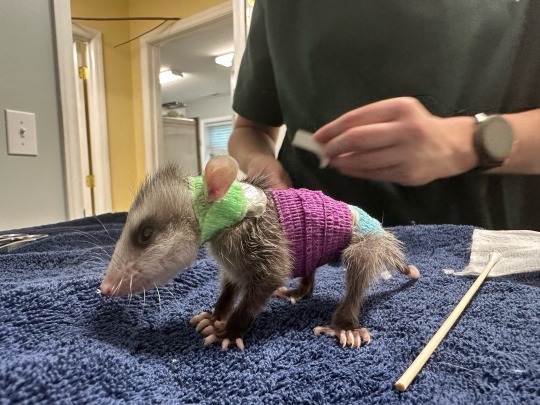
Little guy kept yanking his bandages off, so they needed some reinforcement.
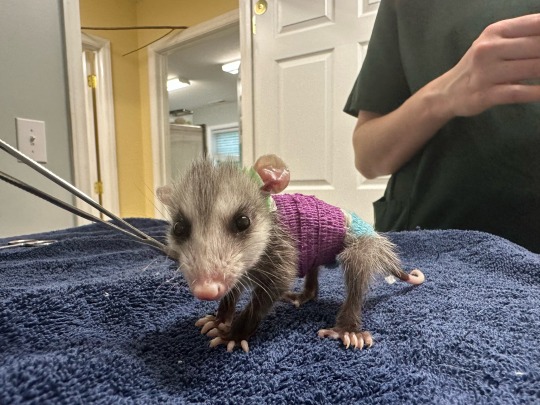
(This is a patient in the process of rehabilitation. She was admitted since her mother , her siblings , as well as herself was attacked by a dog. She has multiple puncture wounds , otherwise she is doing well!)
2K notes
·
View notes
Note
all the videos of "rescues" handling baby wildlife on tiktok make me want to pull my hair out, no reputable WRC would be talking to/petting these baby animals! they won't be releasable! arrrgh
It’s a mistake that is made far too often. I’ve been raising and releasing squirrels for more than ten years and I cringe terribly to think how much I handled them in the early days before I knew better! I worked as a volunteer for a rehabber that didn’t really explain the dangers of habituation. Fortunately I always worked really hard to raise my babies in groups, and I didn’t handle them once they were in their outdoor transition enclosure. I was really lucky that I never had a problem with release, but I greatly regret how much I handled them as babies.
I agree that even in the wildlife rehab world there is sometimes not enough attention paid to reducing risk of habituation. Saw a vid of a rehabber cuddling a young fox they planned to release and my jaw dropped. That said, the places that are good about it are really good and take monumental steps to minimize contact.
219 notes
·
View notes
Text

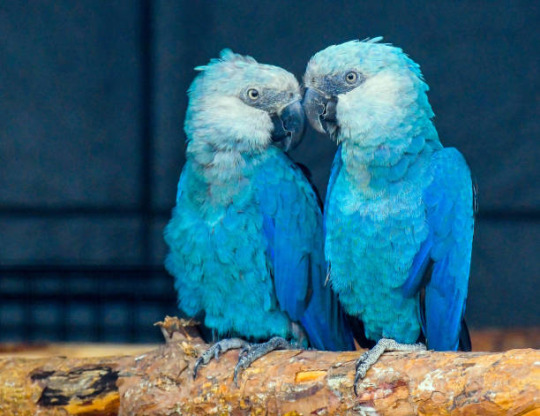
earth fact time. SOME GOOD NEWS!!! the spix's little blue macaw, which has been extinct in the wild for 22 years, have now come back into their home in brazil!
in 2022, 52 captive-bred birds were released back into the wild! they're one of the rarest birds in the world, with only 250 or so in captivity. as of now, the macaws are still alive in the wild and doing well! they also return daily to the spix's macaw release centre to visit their captive flockmates.
if you think they look familiar, they're the same species as blu from the movie rio.
forbes (june 2022) | forbes (july 2022) | birdnote | science.org
photos: patrick pleul
#terrestrial#earthposting#facts!#birds#parrots#macaws#spix's macaw#spix's little blue macaw#biology#zoology#ornithology#good news#birdblr#parrot#wildlife rehabilitation#tropical birds#animals#earth fact no. 22#hope
71 notes
·
View notes
Text
Also if you find a wild animal and are sure it’s in need of rehabilitation (after asking an educated rehabbed or the like), still don’t feed it! I can’t tell you how many times we’ve had people call in and explain the situation while mentioning that they fed it. Of course they had good intentions, but that doesn’t always work out.
On top of not feeding wild animals in general to prevent risk of habituation (and please never look it up and try to feed it on your own via some random website), you also shouldn’t feed them because allergies are a thing too, as well as choking! We had a pair of baby squirrels come in and they’re feet were purple. Purple. Surprise, that’s not how it’s supposed to be! I talked with the person who found the squirrels and they said they had read to feed it goats milk, which it ended up being allergic to.
It’s best to leave it up to people that know what they’re doing. We see you trying to help! Thank you so much for your interest in saving animals, but there’s only so much you can do.
#wildlife rehab#wildlife rehabilitation#wildlife#tw animal injury#I think?#also don’t feel bad if an animal dies while you’re trying to transport it#sometimes that just happens#keep your cats inside and you’re usually good#you did the best you could and we see you!
150 notes
·
View notes
Text
Deconstructing the "Peggy and Molly Friendship" Narrative
Molly the Australian Magpie had been “reunited” with Peggy and the family that stole him as a fledgling and raised him without any wildlife carer license or experience.
Thanks to the Queensland Premier wanting to score some extra points in an election year, he “made it happen.” And legitimised the collective delusion of the public that genuinely thinks that this was a completely okay and reasonable situation. And believed the notion that Molly, a territorial social species of bird that had compromised development and was taken out of his home range, could simply "fly away".
So I went through their Instagram to see how this madness unfolded. It clearly began as a “Peggy” instagram before the stolen fledgling joined in.
These people are so adamant that there were no parents around but I don’t believe it for a second. Molly was a juvenile when he was taken - you always see fledglings around his size and age on the ground foraging for food. Mum and dad are not always around but they are never far away and are critical to a young magpie's developmental period.
They claim that Molly was sick. Yet they never make any mention of taking him to the vet. Molly makes distinctive fledgling feeding calls, the sounds he would have used to beg for food from his parents. It's tragic to see this after seeing how magpies raise their fledglings in my own backyard.
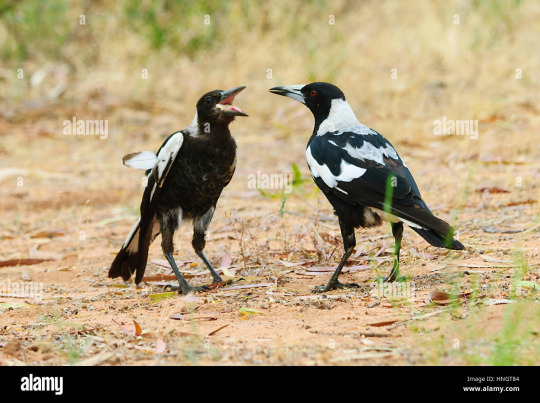

One of their first posts is feeding him what looks to be mealworms next to their pet dog. Aussie Magpie Fledglings at this age are learning everything about how to survive from their parents. They fed Molly WITH their dog. What does that teach? That dogs are not only safe but also a potential source of food/reinforcement.
As Peggy’s Instagram becomes Peggy and Molly’s Instagram, this happens:

Molly gets attacked by other birds. Because guess what? This is a territorial bird who has been removed from his original territory and away from the protection and guidance of his parents.
So, because these people have no idea what they’re doing, they’re Shocked that this would happen and that the wild bird they’re unwittingly conditioning into their pet can’t defend himself.
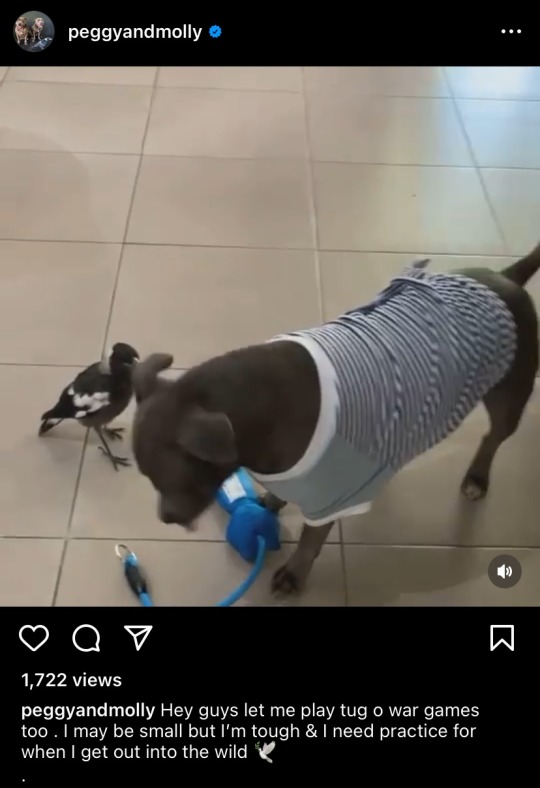
But yeah I’m sure teaching Molly tug of war with a dog is exactly the survival skills he needs as a wild bird!!!!!!
(I’m losing my goddamn mind)
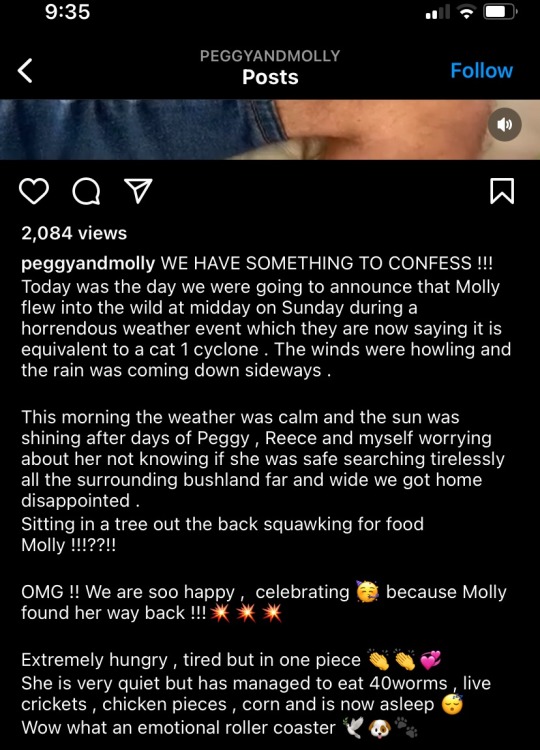
Another “release attempt” fails because apparently we did a whoopsie and let him fly out in a storm??? Yet again, this poor bird is having traumatic experiences in the wild that he was not prepared for and is, unsurprisingly, seeking humans - which he has now associated heavily with food and safety.
Meanwhile, as they’re “raising” Molly, this insanity happens:

Yeah because that’s why your staffy is spontaneously lactating. She wants to mother a bird. It couldn’t possibly be that she’s had a bird pecking at her nipples and stimulating them or that she might have a serious medical issue. Interestingly, they do take Peggy to the vet. A luxury that doesn’t seem to be afforded to Molly who was also apparently sick (even though he seems to be pretty bright, alert and feeding in all the videos of when he was “rescued”)
Anyway the saga continues with the clear intention of making content now - the socialisation and habituation continues during Molly’s most critical juvenile years. They talk about how Peggy is helping Molly learn how to find food as if they're still intended for him to be a wild bird. But it's clear this bird isn't going anywhere.
At this time, Molly would be learning how to find food, how to socialise with other magpies and he’d eventually be joining a juvenile or bachelor flock where he’d continue to develop his social skills as a social and intelligent bird, wrestling and playing with his flock mates.
But no, he’s learning to mimic barks and is harassing the hell out of this poor staffy. The family just lets it all happen without any sort of support or advocacy for Peggy.
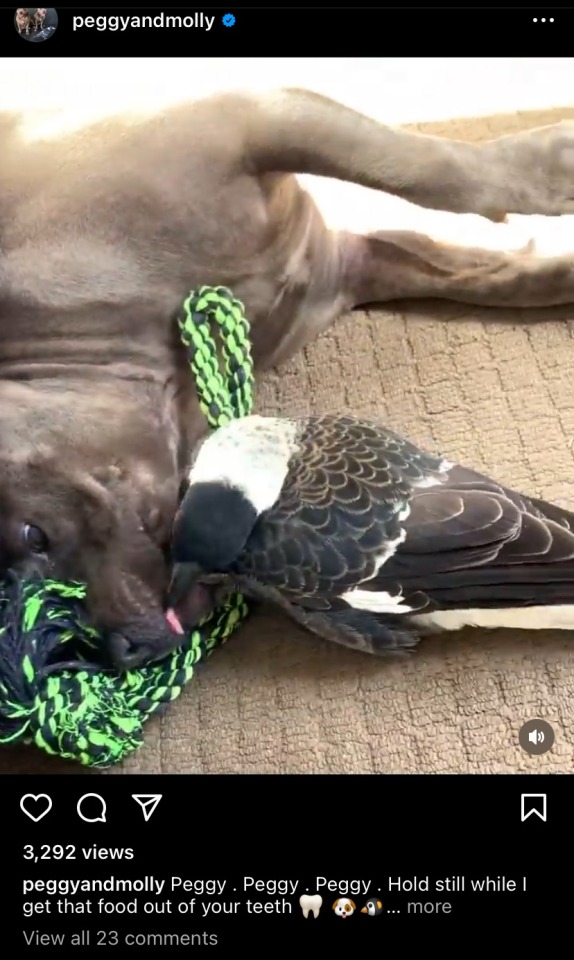
Haha isn't zoonotic disease vectors and a confused bird with no idea of how to interact appropriately with a dog just hilarious? It’s funny because of the silly caption they made, right?
As their "relationship" progresses, Peggy shows more discomfort.

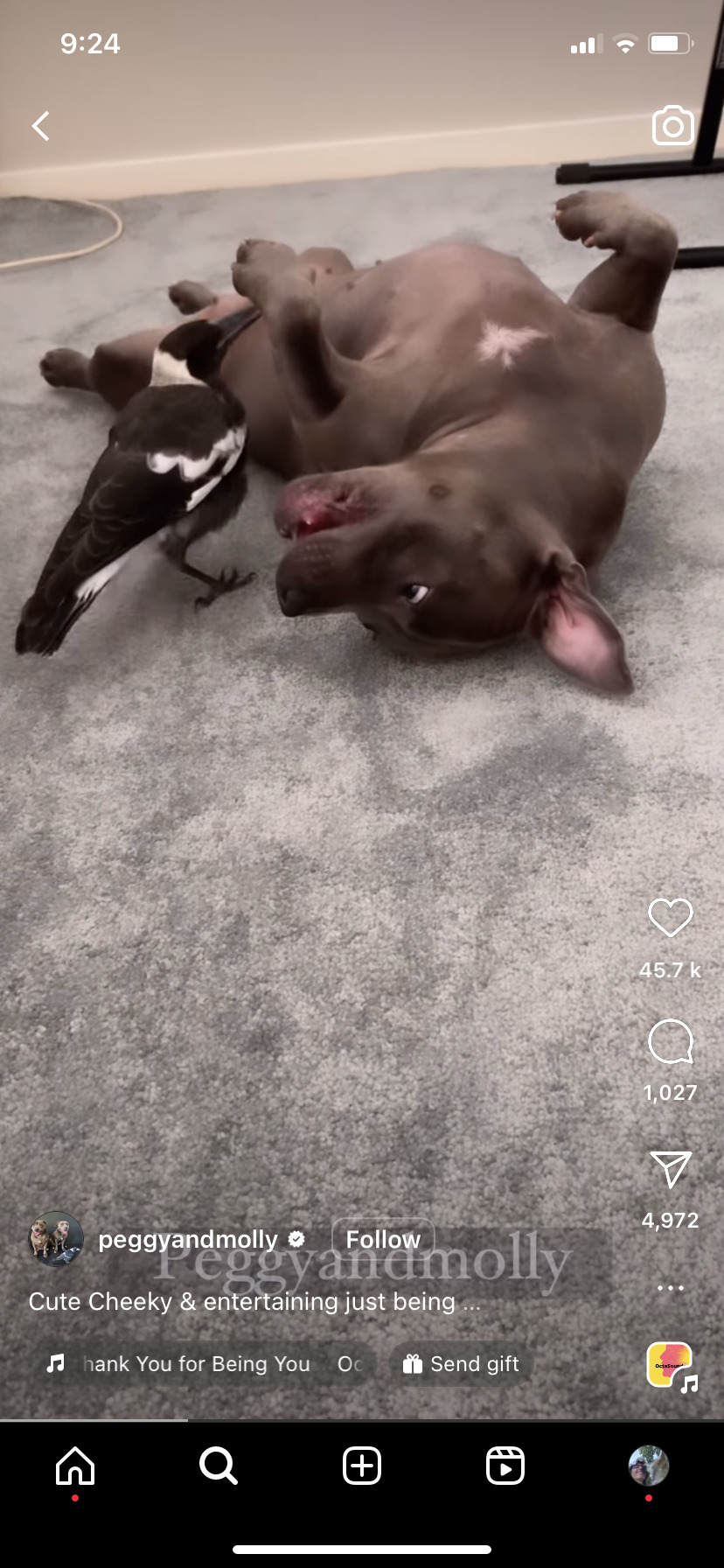
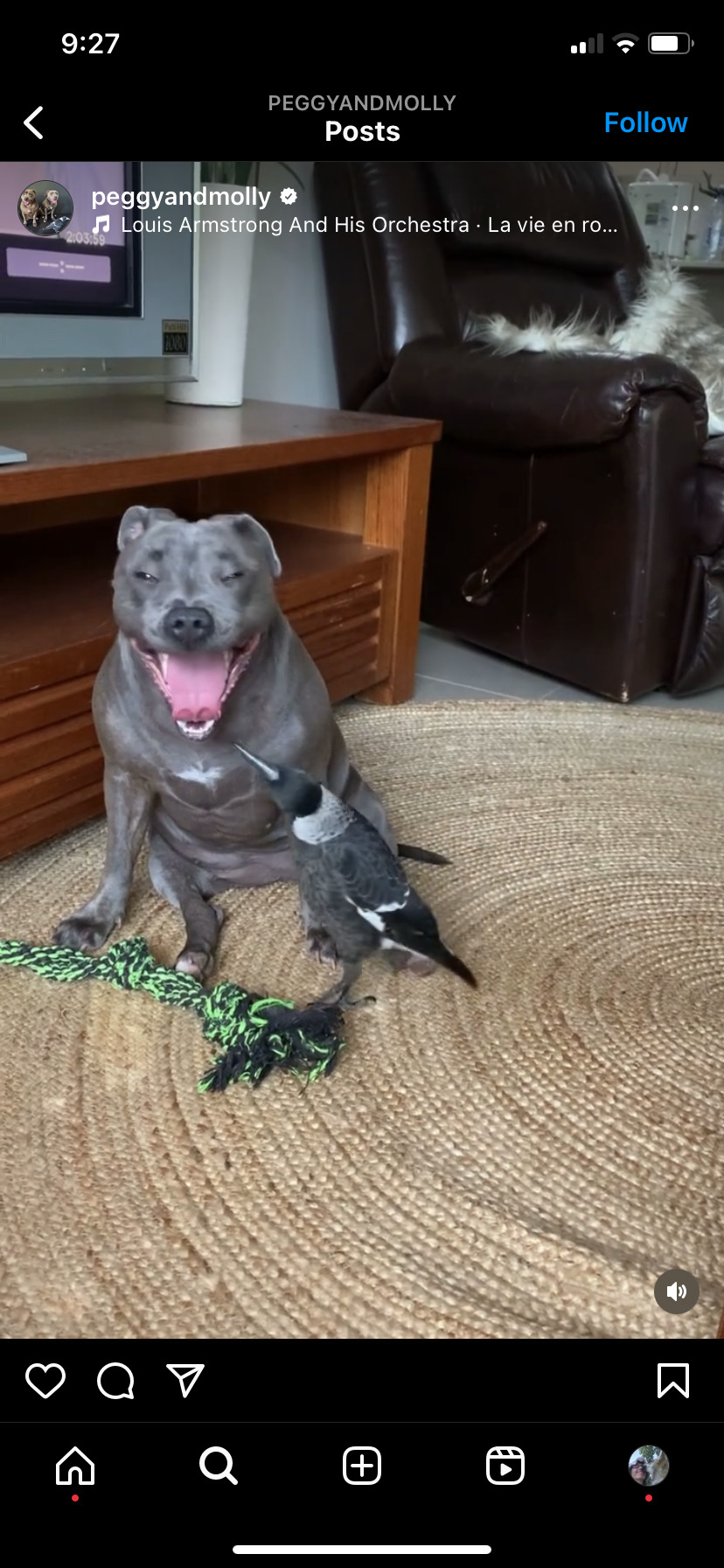
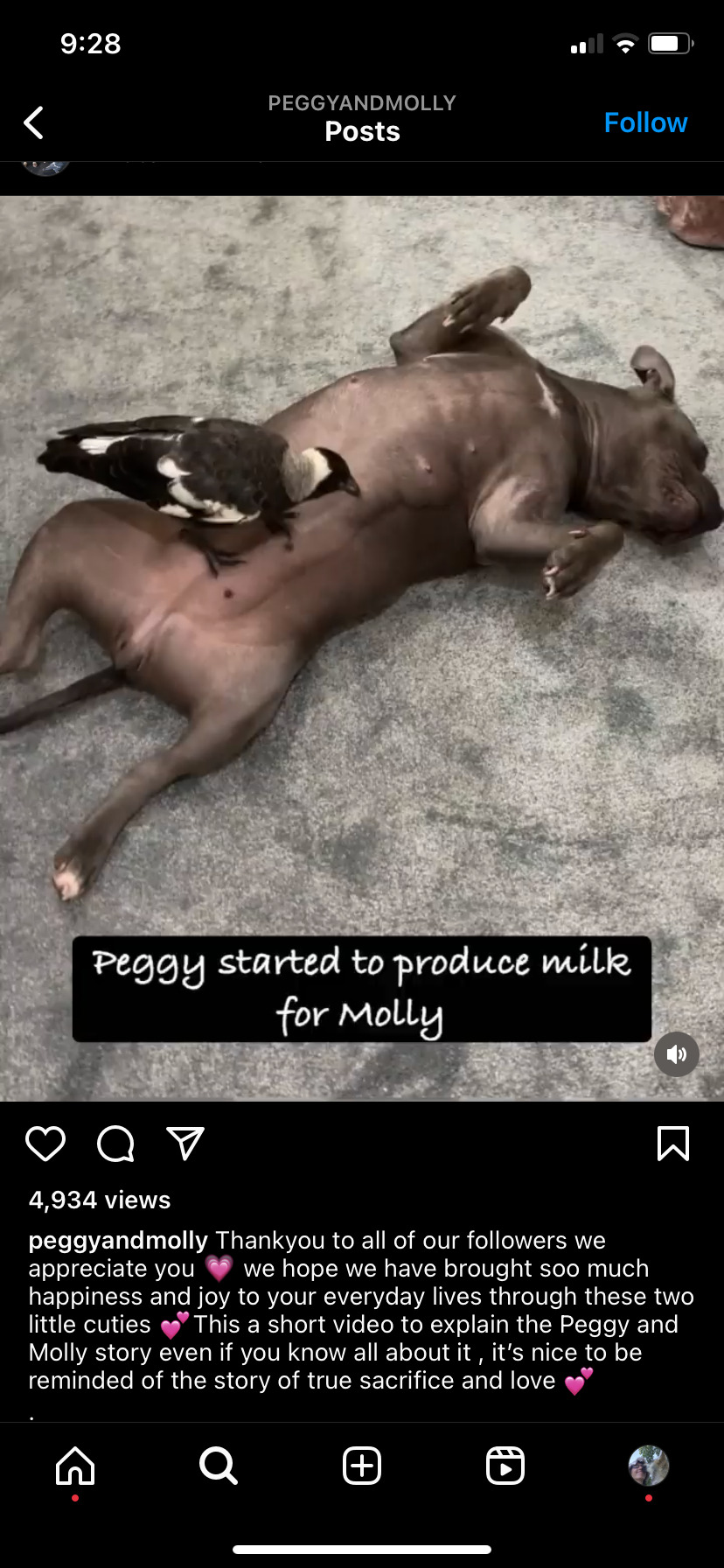
This dog shows multiple stress behaviours. She is not friends with this bird she is TOLERATING this bird as he pecks at her face. She's rarely relaxed in these "play" interactions. She licks her lips, turns her head, yawns and even bares her teeth. But if it has a cute soundtrack behind it, I guess that means they’re having fun, right?
Even the interactions where Peggy's isn't stressed are still uncomfortable to watch. Molly shows immense frustration and confusion, following and wanting to be involved but being ignored or tolerated.
Molly should be with wild birds, playing how they play and not being merely tolerated:
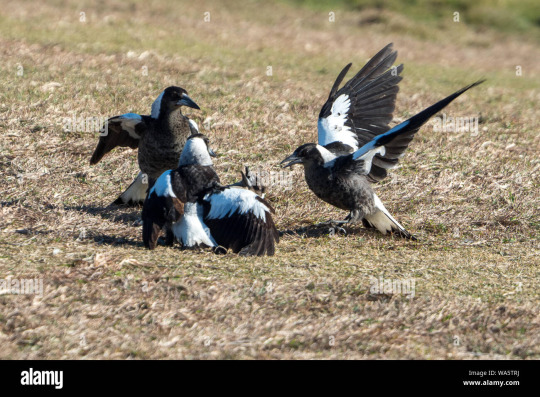
Molly had a chance to be homed with a qualified wildlife rehabber or even get the chance to get to live with other Australian Magpies. But because people fell for the story and the media regurgitated it without questioning it for a second - he'll never get that chance again.
Molly was failed by the Queensland government for not being seized immediately. There were numerous complaints as soon as their story started to become viral that this was sending a bad message to the public and that this bird was not being given the care he needed.
It's too late, now. Molly will live in a confused limbo, not knowing what he's supposed to be and will never get to live with his own species.
And all the people that sent death threats to wildlife carers (who were trying to fix the damage caused) will pat themselves on the back about what a good job they did.
#Molly the Magpie#wildlife rehabilitation#australian magpie#wildlife#birds#canine behaviour#stress behaviour#Peggy and Molly
26 notes
·
View notes
Text

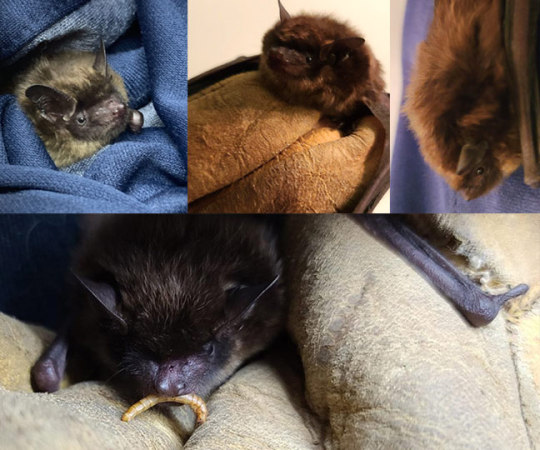

Calling all bat lovers! Next up to unlock on our Kickstarter fundraiser is the bat pendant! Stickers, prints, and the original watercolor painting are also available: Learn more at: tinyurl.com/me9r66ac
A lot like vultures, bats are ecosystem superheroes who need good PR and more positive representation in art and media, so I was really happy to work on this design. We are experimenting with some transparent glass-like enamel effects for the wings of these pendants, and I think they will turn out really eye-catching and unique!
When I first started in wildlife rehabilitation, I ended up working with a lot of bats, which really increased grew my fondness for them. Even though I specialize in birds and don't usually take mammals, I can't turn away a bat in need (the photos are of some of our brown bat rehab patients).
Thanks for taking the time to look. Shares greatly appreciated if you know anyone you think might enjoy!
38 notes
·
View notes
Text
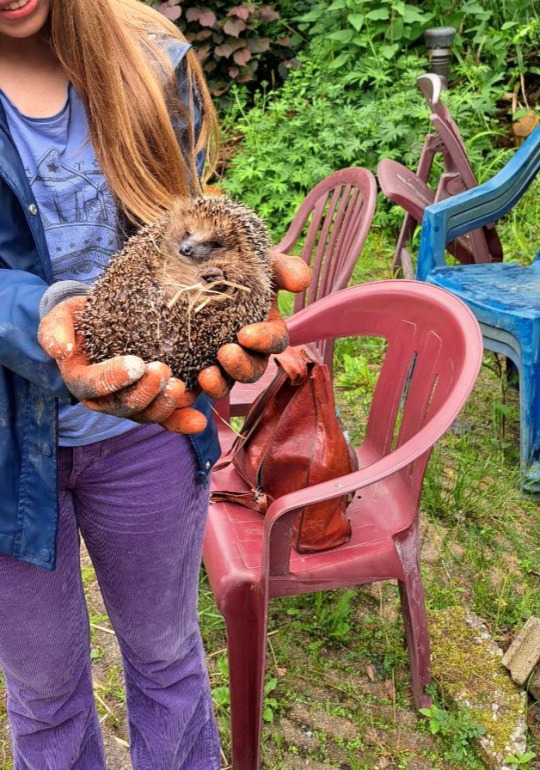




some pictures of the two hedgehogs from the wildlife rehab I released in my garden today.
🦔🦔❣️ to freedom! and many slugs.
53 notes
·
View notes
Text
youtube
For those that don't know, I make social media content for a wildlife rehabilitation centre. Earlier this year we launched a video series about the science of wildlife rehabilitation called Alberta Wildlife Insider. Each episode walks through the reasons a particular species comes into care, what that care looks like, and how we return them back to the wild.
The 2nd episode (above) just dropped and is about great horned owls! You can go to our channel watch the 1st episode about rehabbing black bear cubs.
9 notes
·
View notes
Video
youtube
A snowshoe hare viciously and relentlessly attacks a worker at a wildlife rehabilitation center in defense of another hare.
Warning: UNSPEAKABLE VIOLENCE!!!
55 notes
·
View notes
Text
Eni is all grown up now! I guess her age to be around 18-22 days, and she now refuses to take milk even as a snack, and moved out of her washcloth nest into the woodchip bedding.
She now eats grains (a special mouse diet) and greens from the garden, and drinks normal tap water.
She still climbs on my hand when i reach into her tank, and still greatly enjoys being petted, but the change from baby to adult is pretty stark.
Throwback to last tuesday when she arrived:


Helpless, eyes closed. She was found by a 9 year old girl at a gas station, her mother adked if I could take her in. I promised to try my best ❤
To today:


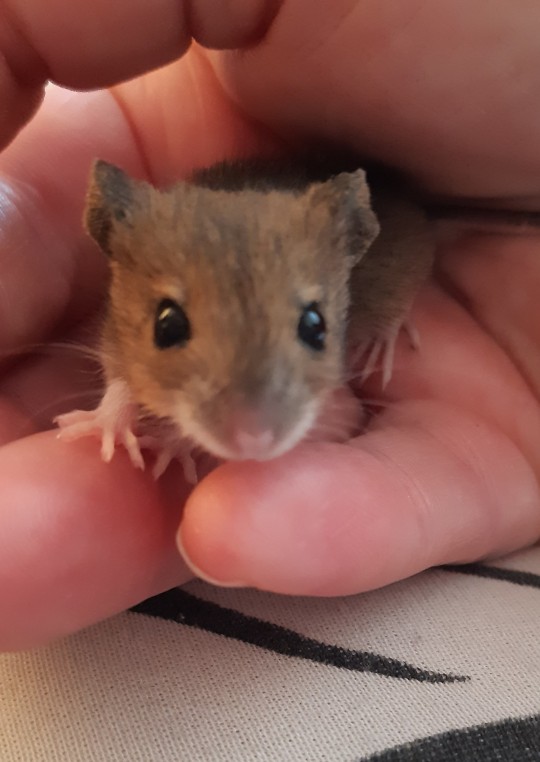
It was so heartwarming and exciting (and exhausting) to raise her. I'm beyond relieved that she survived under my care, and I hope I'll be able to give her a happy, spoiled, enriched life as a human pet. I couldn't release her out into the wild. We have 4 martens, foxes and badgers in the garden - she'd be an easy snack for them and I can't let that happen.
Call it selfishness.
#cute#animals#mouse#baby mouse#rodents#eni#eni the mouse#pets#my pets#tw: mouse#wildlife rehabilitation
20 notes
·
View notes
Text
A very angry baby who is furious that we would dare to remove his fleas, give him fluids and offer a nice square meal after someone brought him in dehydrated and emaciated. This feisty little escape-artist was stabilized and handed off to a rehabber prior to release. Good luck out there little firecracker!
3K notes
·
View notes
Text
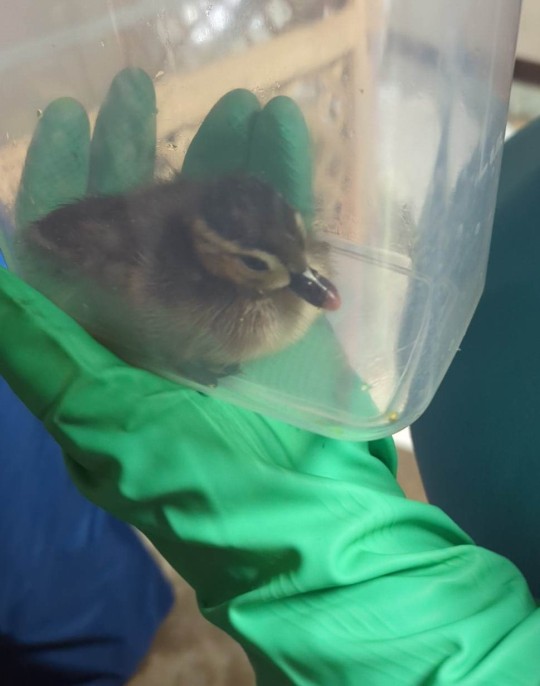
Arte found this lil baby in his window well this morning, jumping and peeping away! Poor little one got separated from mom, but lucky enough to get stuck at our house, and we found them before any of the 15 outdoor cats on our street.
Baby is a wood duckling! They're smaller than mallard ducklings, they jump A LOT, and the line from their eye only goes backwards, it doesn't go between the eye and bill. Wood ducklings are also more fragile and easily stressed than mallard ducklings, so it's extra important not to handle more than strictly necessary, and to keep them in a dark, quiet place until you can get them to rehab.
This unlucky/lucky baby was taken to a local rehab along with a donation for all of the wonderful work they do!
#wildlife#wildlife rehabilitation#wildlife rescue#waterfowl#wood ducks#no ducks in sight and little one was very tired from jumping#so not sure how long they were trapped but seemed unlikely to be able to find mom#the best rescue is reuniting but unfortunately not always possible
30 notes
·
View notes
Note
What is a favorite fact that you like but feel like you never have a chance to share? More than one favorite is also totally acceptable.
The Virginia Opossum is not only the only marsupial in North America, but it also has the shortest pregnancy of all mammals which is 12-13 days (the water opossum of Central America is also 12-13 days). On the other hand elephants have the longest pregnancy at 22 months. When Virginia Opossums are born, they are about the size of an American dime or a honeybee and weigh 0.13 grams (about the weight of 2-3 grains of rice). Virginia Opossums have between 8 and 25 babies per litter, but have to crawl up their moms belly (with only front legs and while completely blind) and attach to one of 13 teats. Once they attach, their jaws lock down till they are about two months old. If a baby is dropped by mom for any reason, she will not come back for them. Wildlife rehabbers can feed baby opossums with a small tube that goes into their stomach due to the fact that opossums can’t swallow at a young age and their mothers teat grows with them and stays in their stomach till they deattach. I have worked as a wildlife rehabber since 2008 and my specialty has always been opossums. I have raised them as small as 6 grams in weight which seems impossible to a lot of rehabbers out there. I will attach some photos. (Oh an Virginia Opossums have a pronged p3n1$ and females have two uteru$’ to support this.)
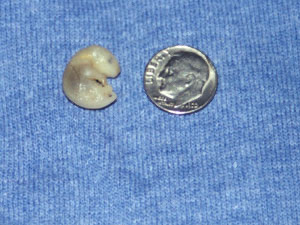
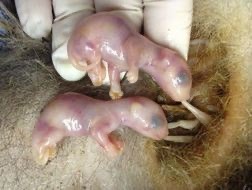

#random fact#virginia opossum#opossum#baby opossum#animal facts#facts#wildlife rehabilitation#wildlife rehabber#wildlife warrior
18 notes
·
View notes
Text
PSA
If you find injured or sick Native Wild Animals during the summer (or anytime) please please please:
CALL your local Wildlife Center/Rehab and get the animal there ASAP or follow whatever instructions they give you
DO NOT try and rehabilitate the animal yourself
[1] In the United States, (I'm think) it is Federally Illegal to house Native Wildlife for more than 24 hours without a license to do so.
That 24 hours is only there as a grace period to get the animal to a wildlife center/rehab
[2] Centers/Rehabs have the facilities, materials, and knowledge to take care of the animal
Google is not your friend when it comes to wild animal care! Just bring them to a center/rehab.
Also, some centers/rehabs are specialized for either birds, or specific mammal types, so CALL AHEAD to ensure the animal gets to the appropriate center for recovery
[3] If you attempt to rehab a wild animal yourself and then bring them into a center/rehab, unfortunately the longer the animal goes through improper care, the more likely the animal will have to be euthanized
We try our best to treat and rehab every animal that comes in, but sometimes it's not enough
[4] The goal of Wildlife Rehabilitation is releasing, not making them pets. Keep the Wildlife Wild
The less time the spend around people the better off they will be at release. Avoid (baby) talking around the animal to the best of your ability.
Also, I say "native" because non-native animals have to be euthanized; it doesn't matter how little impact they hold on the native environment or how endangered they are as a species (it really fucking sucks)
Unfortunately I do not know if alternatives for endangered non-native wildlife.
#please share this#I am just an intern but ask questions if you have them!#PSA#public service announcement#wildlife#wildlife rehabilitation#animals#wild animals#wildlife centers
25 notes
·
View notes
Text
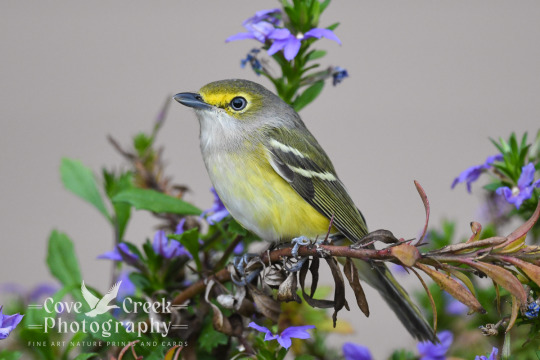
A Bird Hit My Window: What Do I Do?
Having a bird hit a house window is an unfortunate consequence that can happen at anytime of year. However, during bird migrations in spring and fall, the incidence of bird collisions increases as birds are traveling to their new summer or winter homes. This white-eyed vireo slammed into my neighbor's window, and with a little TLC, it survived, despite being knocked completely unconscious! This leads to the question, "What can I do for a bird that hits my window?" The answer to that depends on the situation. Audubon suggests calling a wildlife rehabber, and that would certainly be the best approach. Unfortunately, many of us don't have a rehabber nearby, and the task of aiding in the bird's recovery falls on us.
Sometimes, birds are only lightly stunned post-collision. Their eyes are open and they are looking around, but show no interest in flying. If it's fairly warm outdoors, and the bird is not at risk of hypothermia, I fashion a makeshift nest out of a clean cotton hand towel, and place the bird in the "nest" and leave it alone. From a distance, I do keep an eye on the recovering bird to see how it responds, and to make sure it stays safe from predators. There's a good chance the bird will fly off within a few minutes; although, I have seen it take as much as 20-30 minutes.
If a bird is laying on the ground and appears lifeless, GENTLYtry to move its legs. If the legs are stiff and don't move, the bird is likely deceased, and nothing more can be done. However, if you can move the legs, the bird is unconscious and there are some steps you can take to aid in its recovery. Line a small box with a clean cotton or paper towel, and gently place the bird in the box. Bring the box indoors and place it in a dark or dimly lit area of your home that is away from noise and pets. At this point, it's a waiting game. It can take as much as an hour for a bird to regain consciousness and clear its head. When you hear it scratching around the box, it's on the road to recovery! At this point, I take the box outdoors and wait for it to fly out of the box.
What if the bird does not recover, and it dies? It's sad, and not the outcome that any of us want, but the unfortunate truth is that this sometimes happens. It's very likely that the bird sustained extreme head trauma, and/or there were other injuries that were not visually apparent.
In the case of our white-eyed vireo, the time from collision to full recovery was about an hour. It regained consciousness within a few minutes, but sat perched on the shrub and looking around for what seemed to be an alarming amount of time. Fortunately, it eventually flew away, continuing its migration south to its winter home.
#bird migration#bird photography#birdwatching#nature photography#wildlife photography#photographers on tumblr#bird injuries#songbirds#birds#bird collisions#wildlife rescue#wildlife rehabilitation
9 notes
·
View notes